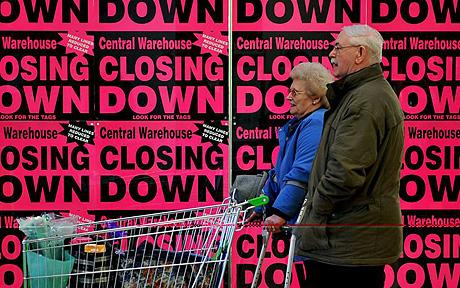The Office for National Statistics in UK has announced that the country’s economy has returned to recession, after shrinking by 0.2% in the first three months of 2012.
A sharp fall in construction output was behind the surprise contraction, the Office for National Statistics (ONS) said.
A recession is defined as two consecutive quarters of contraction. The economy shrank by 0.3% in the fourth quarter of 2011.
Wednesday’s figure is an early estimate and is subject to at least two further revisions in the coming months. It is compiled using 40% of the data gathered for later revisions.
The UK economy was last in recession in 2009.
Prime Minister David Cameron said the figures were “very, very disappointing”.
“I don’t seek to excuse them, I don’t seek to try to explain them away,” he said at Prime Minister’s Questions.
“There is no complacency at all in this government in dealing with what is a very tough situation, which frankly has just got tougher.”
David Cameron said it was “painstaking, difficult” work, but the government would stick with its plans and do “everything we can” to generate growth.
Labour leader Ed Miliband said the figures were “catastrophic” and asked David Cameron what his excuse was.
“This is a recession made by him and the chancellor in Downing Street. It is his catastrophic economic policy that has landed us back in recession,” Ed Miliband said.

The ONS said output of the production industries decreased by 0.4%, construction decreased by 3%. Output of the services sector, which includes retail, increased by 0.1%, after falling a month earlier.
It added that a fall in government spending had contributed to the particularly large fall in the construction sector.
“The huge cuts to public spending – 25% in public sector housing and 24% in public non-housing and with a further 10% cuts to both anticipated for 2013 – have left a hole too big for other sectors to fill,” said Judy Lowe, deputy chairman of industry body CITB-ConstructionSkills, said.
Some have questioned the validity of the ONS’s figures, particularly on the construction industry, which has been particularly volatile in recent quarters.
But Joe Grice, chief economic adviser to the ONS, said the construction data was based on a survey of 8,000 companies and had been carefully checked and double checked.
The latest figures supported the view that the economy had been “flattish” in the past few quarters, he added.
Over the last year and a half, the economy has fluctuated between quarters of growth and contraction.
Bank of England governor Sir Mervyn King has previously warned that the economy will continue to “zig zag” this year.
He had forecast growth in the first quarter but then a contraction in the second quarter, when the extra bank holiday for the Queen’s Diamond Jubilee is expected to reduce output.
“It is clearly not good news, the missing link in the economy has been confidence,” said Graeme Leach, chief economist at the Institute of Directors.
“These are relatively small falls, so we shouldn’t be too alarmist.
“[But] regardless of the figures, it is the message that comes out to business – to be cautious – exactly when we want them to be a little more aggressive in terms of recruitment and investment.”
However, some pointed to other recent business surveys, which painted a more positive picture of the economy.
“These figures are at odds with the experiences of many UK businesses, which continue to operate with guarded optimism,” said David Kern, chief economist at the British Chambers of Commerce.
He added that he expected the preliminary estimate to be revised upwards when more information became available.
The estimate for construction output is based on published data for the first two months of the quarter, and an estimation for the third month.
But the ONS pointed out that, while there was “a tendency for upward revisions” to construction, March would need to be “exceptionally strong” in the construction sector to produce growth in the quarter.
The first estimate of GDP for the last three months of 2011 showed a contraction of 0.2%, which was later revised to a contraction of 0.3%.
[youtube -ugoxa_e_Lk]
